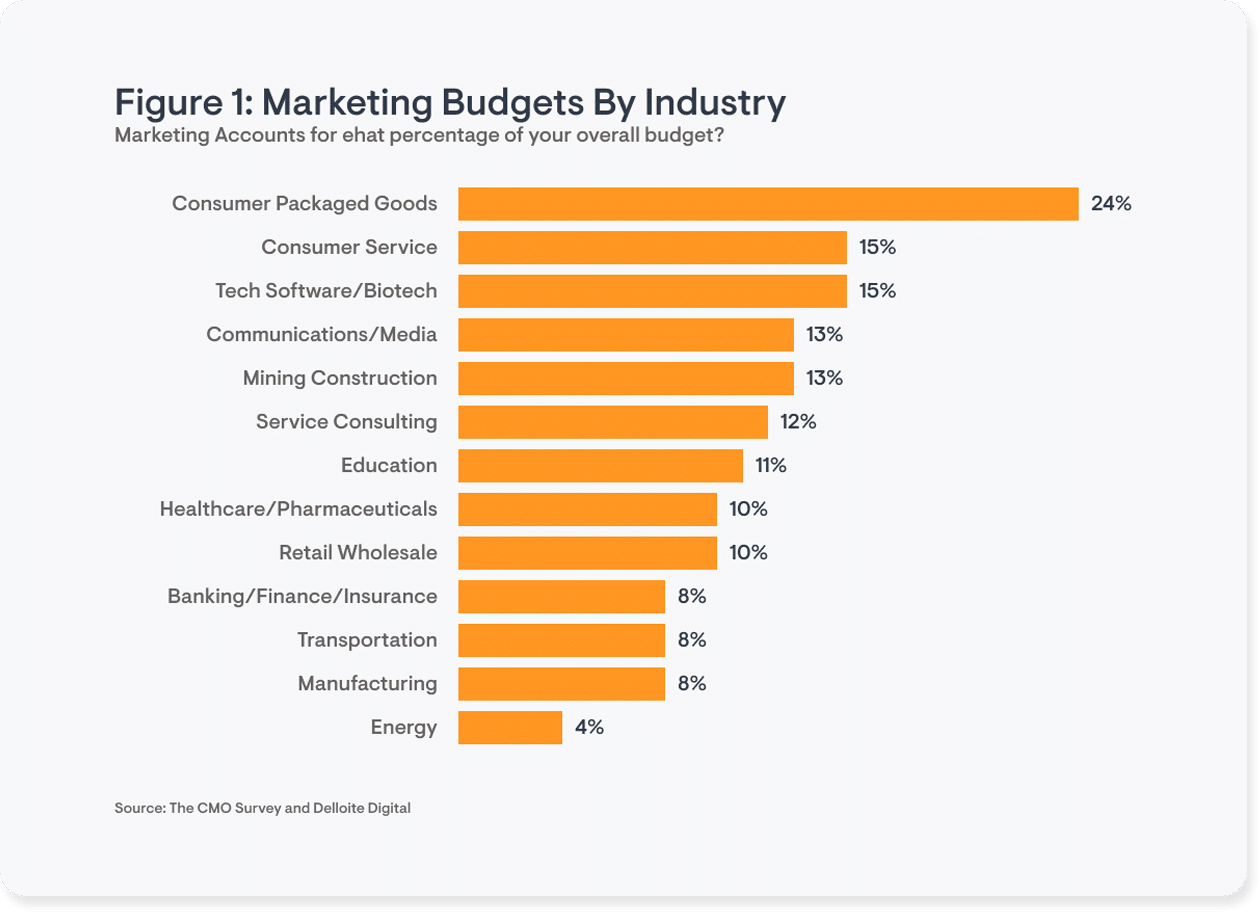10 Steps to Plan Your Marketing Budget: The Foundation for Massive Growth
Understand your estimated costs vs. actual costs and run profitable marketing campaigns by tracking every dollar. You wouldn’t buy a car without factoring in fuel costs, and you shouldn’t run a single marketing campaign without factoring in your budget.
We know you’ve got a lot on your plate already when it comes to running your business and getting customers.
So establishing a marketing budget might be the last thing you want to think about.
After all, the process is usually confusing, time-consuming, and expensive (and it’s hard to find articles online that actually help). It feels easier to just ‘eyeball’ it and do your best, right?
Not so fast.
The truth is, if you’re just guessing when it comes to your budget, you’re likely to waste money and miss out on key insights that can help your business. When you know what money you have available, you can create targeted marketing campaigns designed to drive ROI. No guesswork, and no crossing your fingers and hoping for results.
If you’ve got plans to grow your audience online, generate leads, and drive consistent sales, we’ll cover the basics of creating a market budget. Plus, explain exactly how you can develop a marketing budget that works for you.
Let’s dive in.
The Basics: Understanding your marketing budget
Before we dive into the specifics of how to establish a marketing budget, it’s important that you have a solid understanding of *what* a marketing budget is and why it matters to your business.
What is a marketing budget?
A marketing budget is, quite literally, the money that you set aside to spend on marketing efforts over a specific period of time.
Your marketing budget should include all costs that are associated with marketing efforts, including things like:
- Paid advertisements (Google Ads, Facebook Ads, Remarketing, etc)
- Hiring costs
- Website maintenance expenses
- Marketing tools used
Why do you need a marketing budget?
For many contractors or small business owners, a marketing budget could seem like a low priority expense at best — or, at worst, money down the drain. After all, why spend money on marketing when you could be investing in tangible goods or customer-facing employees?
This is the wrong mindset to have.
Establishing a marketing budget — and, more broadly, investing in marketing efforts, is extremely important. It will ultimately help you:
- Modernize your approach to customer relationships and lead-gen
- Manage your finances
- Allocate funds where they’ll drive ROI
- Develop your marketing strategies
- Create a business plan
Let’s unpack each of these benefits a little before we move on.
Modernize your approach to customer relationships and lead-gen
Marketing has changed dramatically in recent years, with a move away from “traditional” advertisements like billboards, letterbox drops and print, and toward inbound marketing efforts, which provide customers with relevant, interesting, helpful information to make a sale. Setting aside money on the proper resources can help you stay on top of changing marketing trends so you can save money and get more customers, faster.
Manage your finances
When it comes to marketing spend, it’s easy for the wheels to fall off the bus if you’re not careful. Particularly with paid advertisements, costs can quickly spiral out of control — and, if you don’t have your marketing budget under control, it could mean thousands of dollars down the drain. Establishing a clear budget can help you sidestep these concerns and prevent overspend.
Allocate funds where they’ll drive ROI
Marketing today is fairly complex, and it can be difficult to allocate the right funds to the right strategies or marketing avenues. Establishing a clear budget can help, allowing you to funnel resources into proven strategies that really work.
Develop your marketing strategies
If you don’t know how much money you have to spend, it can be harder to know what your marketing options are, where you should spend your money, how much money should go into each channel, or where marketing fits into your larger business goals. A defined budget can provide a lot of clarity here.
Create a Business Plan (with comprehensive goals and KPIs)
Having your numbers under control helps all aspects of your business. By aligning your marketing budget with your broader goals – like sales, conversions, and traffic to your site – you can have a clearer vision and set well-defined goals for your business.

10 Steps to planning a marketing budget
Now that you understand the basics, here are the 10 steps you need to create a marketing budget that will increase your business and improve your company’s health over time.
Step #1 – Get a handle on general marketing options
Before you develop your budget, you have to understand the broader marketing landscape and how much each marketing service and activity costs.
When it comes to services – or how you’re going to carry out your marketing, you have three primary options:
- Train and use in-house services
- Hire a freelancers
- Partner with a digital marketing agency
As a rule of thumb, here are things to keep in mind about each option.
In-house marketing
If you’re going to execute in-house marketing the right way, it’ll mean hiring employees to get the job done.
Costs, then, will come in the form of salaries, training, and marketing tools needed to execute your campaigns.
TRADIE DIGITAL TIP: Don’t expect one of your employees to do marketing “on the side” along with their full-time job. Marketing is a full-time job in and of itself, and expecting someone to do it in their spare time will ensure the job is executed poorly.
Freelancers
If you employ a freelancer who specializes in marketing, you will have to pay them by the hour or based on project milestones.
Freelancing hourly fees may be higher than an in-house employee, but they will likely take less time overall to complete the job (plus, you won’t have to pay benefits or other costs associated with employees).
A marketing agency
Marketing agencies may be pricier than freelancers, but you’re hiring a one-stop-shop for all your needs. There’s no right or wrong choice where agencies are concerned, though you will need to do your homework and compare options to ensure you find the right fit.
Always consider how much money you have to spend as well as your technological limitations.
Step #2 – Understand what marketing strategies to focus on
Next, there are the actual digital marketing strategies that you deploy, some of which include:
- Search engine optimization (SEO)
- Paid ads (Google Ads, Facebook Ads, Remarketing, etc)
- Content marketing
- Social media marketing
Remember, there is no one-size-fits-all strategy that will work for every business, and you will likely find yourselves trying out many different combinations of strategies to see what works best for your business and how. That said, here’s a breakdown of each primary marketing channel to help you find the right fit.
Search engine optimization (SEO)
SEO is the process of improving your website’s search ranking by using the keywords and topics that are “authoritative” according to Google’s algorithm.
In other words, it’s making Google like you so they put your website on the first page of search results. It’s super important — as high as 92% of people only click results that appear on the first page — and difficult to get right. You can read more about SEO and its associated costs here.
Paid Advertising (Google Ads, Facebook Ads, Remarketing, etc)
Pay-per-click advertising, or PPC ads, are the paid ads that appear at the top of search results or in your Facebook Newsfeed.
The idea? You’re paying for the top spot on Google, which can be really helpful If you can’t master SEO or you want instant results. There are a few benefits to PPC campaigns that revolve around speed and control, including:
- You can guarantee eyes on your ad while it is running
- You can customize who sees your ad based on location, online behavior, or other settings
- You can get results fast
- You can scale up or turn off your ads based on real-time data
That said, paid ads are a short-term solution since, as soon as you stop buying them, your business will fall off the radar. What’s more, the costs can snowball over time if you’re not extremely skilled and aware of your budget.
Interested in learning more about Google Ads? Click here for the simple, jargon-free guide

Content marketing:
Content marketing refers to any content – website copy, blogs, emails, social media posts, eBooks, etc. — that you use to reach out to your audience.
The idea here is to share valuable, interesting information that builds trust and strengthens the relationship with your customers. This needs to be a huge part of your marketing strategy no matter what kind of business you run — after all, your content is all the messaging that your customers see, so getting it right is crucial to delivering your message and getting new customers involved with your business.
The steps to getting it right?
- Find the formats that work for you — for many DIY businesses, this can include emails, blogs, and great website copy.
- Make sure that you understand what kind of content your customer wants to see. Do they want how-to videos? Before and after? Here, you can test things out and see what content gets the most engagement.
- Come up with a schedule. For example, you could post new blogs once a week or new social media posts once a day.
- Stick to that schedule. Today, more than ever, customers expect consistency, and they’ll be turned off by your business if you go MIA for huge gaps of time.
Social media marketing:
Social media marketing helps you reach your customers directly on social media platforms like LinkedIn, Twitter, TikTok, and Instagram. This is the most informal of marketing strategies, and it can be extremely effective.
You can read more about the advantages and disadvantages of social media marketing here.
Email marketing:
Email marketing helps you follow up with your customers and stay top of mind. This is crucial as 98% of website visitors will leave your site without being ready to buy from you. With email contact you can stay in touch with this majority and help guide people towards a sale.
For this reason, it’s an extremely effective marketing tool, and you shouldn’t be shy about dedicating a significant amount of your budget to email marketing efforts. You can establish lots of different email campaigns – including welcome emails, ‘You left this in your cart emails, or newsletters – to keep the conversation going, promote deals, and more.
Which of these marketing strategies is right for you?
Here’s the thing: you can’t do all of these things well, and they may not all be a great fit for your business.
For example, if you run a local business that relies primarily on foot traffic, focusing on nationwide SEO might not make as much sense as sending personalized follow-up emails.
Familiarize yourself with your options and get a general idea of which strategies you’ll want to deploy before you try to establish your budget.
Step #3 – Outline your sales funnel
Once you know how you’ll be marketing and what strategies you’ll be focusing on, you’ll have to outline your sales funnel. This sounds complicated, but it’s actually pretty straightforward.
Basically, your sales funnel is the path that your customers take from the second they become aware of your company until they make a purchase and become forever customers. There are four main steps to any sales funnel:
- Awareness
- Consideration
- Decision
- Action
The marketing strategies you use should target your potential customers in each stage of the funnel, helping to guide them towards the final step (which is a sale, consultation or booking with you).
Awareness
During the awareness stage, your customer is becoming aware that they have a problem, and they may start looking for solutions.
For example, a new homeowner might look into their backyard and realize that they might need some help with landscaping.
However, might not yet know what that help looks like — will they hire someone? Take care of it themselves? — or exactly what they want to do (add a pool, create a garden, etc.) At this stage, you’ll want to present them with super helpful information that targets their problem, NOT your business. For example, “10 Landscaping Ideas to Spruce up ANY Outdoor Space.”
Remember, you don’t want to try to sell yourself yet. Your audience isn’t ready (yet).
Consideration
During the consideration stage, your audience starts to evaluate options and figure out what they want to do. The same information could work, but you could give them more detailed information like ‘How to Choose Between an In-Ground vs. Above Ground Pool’ or ‘Do You Need a Professional Landscaper?’
Decision
During the decision stage, the customer starts to narrow their focus and look for the best product or solution. They want details, like timelines, materials, prices, and more. Consider creating resources that compare options to help people make their decision with your business as the solution.
Action
This is when a customer chooses a business and becomes a customer. During the action phase, they will act accordingly. This could be filling out a “contact us” form, making a phone call, sending an email, etc. The point, though, is that they will get in touch and begin the sales process.
You will need to spend money on each phase to market to your customers effectively.
Why? If, for example, there’s no introductory information helping them work through their problem, they’ll never find their way to their website. Or, if they do, they won’t trust that you truly understand them, which means they’ll drop off at the consideration stage. That’s why you’ll have to provide information for all stages.
This requires that you understand:
- How customers find your business
- What information they want to know before making a purchase
- All the factors that contribute to their final decision
Then, you’ll need to make sure that all the right information is on your site.
Step #4 – List all your other costs
Next, you’ll need to understand the bigger picture and all your other costs.
After all, if you don’t have a firm understanding on all your business costs, you won’t be able to accurately determine how much money you have to spend on marketing. You’ll need to gather information about:
- Your operational costs (how much it costs to create and ship products, sales tax, web hosting)
- Employee costs, including outsourcing fees
- Overhead costs (rent, water, electricity, etc.)
- Anything else.
You can do this in a simple spreadsheet — the important thing is to have all your numbers there. This can not only help you understand your broader numbers but also allow you to effectively establish your marketing budget.
If, for example, you sell a product that costs $20 to make and you sell it for $100, then you have $80 of profit. You can spend, for example, $20 on marketing and still make plenty of profit.
Step #5 – Set marketing goals
Next, establish what you want to accomplish with your marketing. Options include:
- Increase sales
- Increase leads (the number of people that enter your sales funnel)
- Increase the number of quote requests
- Increase your social media following
And this can be fairly intuitive – what are you trying to achieve more of every day? That said, it’s important that your goals are SMART – specific, measurable, achievable, relevant, and timely.
So, instead of just saying you want to increase the number of quote requests, your goal should be, for example, to “Get 5 more quotes each quarter in 2021.” This gives your team something precise to measure and achieve.
Don’t know where to begin? Start by figuring out how much revenue you want to make. Then figure out how many sales you need to reach that number and how many leads and customers you need to achieve those sales. This will give you some solid numbers to start with.
Step #6 – Conduct competitor analysis
Next, you’ll need to take a step back and look at the bigger picture of what’s going on in your industry and with your competitors.
That means:
- Looking at the analytics and data to determine what companies your audience actually views as your competition. This can often be extremely illuminating, since the companies who you see as competitors may not be who your customers actually go to.
- Analyzing competition’s websites, products, and services, including the sales they offer, the language they use, the blogs they write, etc.
This kind of research can be extremely helpful.
If, for example, your competitor has more sales – or you find that a lot of your leads end up choosing them – look at what they’re doing.
What does their website look like? Are they on social media? What language do they use? What kind of marketing strategies do they deploy?
If you do your research and figure out their secret sauce, you can also figure out how to one-up them and drive success.
Here, a social media monitoring tool can help you monitor the landscape, and a tool like Buzzsumo can help you find the content that performs best.
Step #7 – Break down your budget
Now it’s time to figure out your marketing budget.
To determine how much of your budget should go to marketing, you can look at average marketing spend in your industry.

Alternatively, you can determine your marketing spend based on other factors like:
- Your business age: Generally, businesses that are between 1-5 years old should invest more toward marketing (12-20%), while businesses that are older than five years old should only invest 6-12%.
- What market you’re working in: B2B businesses tend to invest less in marketing (about 7-8% of their revenue) than B2C businesses, which should invest around 9%.
Step #8 – Create your big-picture marketing plan
Using all the information that you’ve gathered, the next step is to develop your marketing plan.
Again, the information you’ll need to create this plan includes:
- The money you’ll need to spend to achieve your marketing goals
- The tools and overall marketing strategy you’ll use to get started
- An understanding of your customers and how they move through the sales funnel
From there, come up with short-term and long-term marketing strategies. If you want to focus online, this could include:
- A re-do of your website with SEO optimizations
- Weekly social media posts
- A blog to target industry keywords
- Updating your product pages to be more modern
Once this plan is established, you’ll have a clearer understanding of your budget and how things will go.
Step #9 – Track your results
When you have your marketing plan and your budget in place, you’ve still got a couple of key steps to go.
Remember, how you plan things and how they *actually* go are two different things, and it’s important to track how well you stick to your budget and which of your strategies are working.
To get this right, it’s important to:
- Consistently track your budget against your actual marketing spend.
- Measure engagement with your ads, content, and social media posts. If you’re not getting the results you’re looking for, it’s important to pivot quickly and decisively
- Determine what marketing efforts are most effective — meaning they generate the most revenue and engagement — and redouble those efforts.
Remember, marketing is a constant practice, and you must stay on top of your game.
Step #10 – Make changes as necessary
Finally, be prepared to change things up.
Perhaps, for example, you find that how-to blogs perform much better than any other blog format, or that your customers respond particularly well to behind-the-scenes social media posts.
It’s important that you consistently pay attention to these details and make changes regularly.
In other words, do more of what works and less of what doesn’t. It’s the only way you will continue to thrive.
Ready to create a clear, systematic marketing budget to elevate your business?
Alright, we’ve hit you with enough theory, so here’s the most important takeaway – your marketing budget doesn’t have to break the bank.
On the contrary, a smaller but carefully planned and directed marketing budget can help your business make more money and thrive long-term. It’s not the cost that makes or breaks your success, it’s a framework including:
- Find the strategies that work for you
- Use your competition as a guide
- Test multiple marketing channels to gather data
- Plan and adjust as necessary
Don’t know where to start? At Tradie Digital, we can help you beat the competition and develop a proven digital marketing strategy that won’t just pique interest, but get customers to actually take action and request a quote from your business. This can include many different professional options like a comprehensive Google Ads strategy, an updated and interesting website, search engine optimization and more. Check out our marketing services at Tradie Digital to learn more about marketing, where to get started, and how to get it right.







